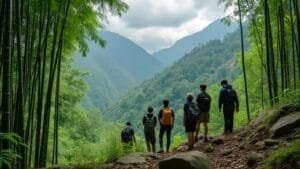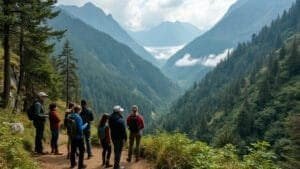Introduction
Red pandas, native to the temperate forests of the Himalayas and other high-altitude regions, are increasingly threatened by habitat loss
Habitat restoration projects are vital to reversing these declines, as they rebuild forests, reconnect fragmented habitats, and improve biodiversity. By addressing the root causes of habitat degradation and involving local communities, these projects provide a lifeline for red pandas
This article explores the importance of habitat restoration, key strategies involved, and examples of successful initiatives that support red panda populations
The Importance of Habitat Restoration for Red Panda Conservation
Habitat restoration is a cornerstone of red panda conservation efforts, providing these elusive mammals with the resources and connectivity they need to thrive
Restoring forests addresses the root causes of population declines and helps rebuild ecosystems critical to their survival. Below, we examine the concept of habitat restoration, the impacts of deforestation on red pandas, and how restored forests contribute to their well-being
What Is Habitat Restoration?
Habitat restoration involves the process of rehabilitating or recreating ecosystems that have been degraded, fragmented, or destroyed
For red pandas, this means replanting native trees, restoring bamboo undergrowth, and creating conditions that support the biodiversity of their natural forest habitats
Red pandas rely on specific forest types, primarily temperate and subtropical forests rich in bamboo, for food, shelter, and protection from predators. Habitat restoration ensures these elements are replenished and sustained, providing the necessary environment for red panda populations to recover and grow
Projects often focus on reversing deforestation caused by logging, agriculture, and urban expansion. These efforts include planting native tree species, stabilizing soils to prevent erosion, and removing invasive plants that outcompete native vegetation
By restoring forests, conservationists create safer habitats for red pandas and support the broader ecosystem that depends on these landscapes
Deforestation and Its Impact on Red Panda Populations
Deforestation is one of the leading threats to red panda populations. As forests are cleared for timber, farming, or development, the red panda’s habitat becomes increasingly fragmented. This fragmentation isolates populations, making it harder for them to find mates, access food, and avoid predators
Moreover, the loss of bamboo—a primary food source for red pandas—leaves them struggling to meet their nutritional needs
Studies in Nepal and India have shown that deforestation reduces bamboo density, forcing red pandas to travel longer distances in search of food. This increased energy expenditure weakens their health and decreases reproductive success
Habitat loss also exposes red pandas to greater risks from poaching and human-wildlife conflict. Without dense forest cover, red pandas are more vulnerable to predators and accidental capture in traps set for other animals
Additionally, fragmented habitats often bring them closer to human settlements, increasing the likelihood of negative interactions
Restoring degraded areas helps reverse these trends by reconnecting fragmented habitats and replenishing vital resources, creating a safer and more sustainable environment for red pandas
The Role of Restored Forests in Red Panda Survival
Restored forests play a critical role in red panda conservation by providing essential resources and improving habitat connectivity. Newly planted trees and regenerated bamboo patches create foraging opportunities and shelter, reducing the pressures of habitat loss
Additionally, restored forests often serve as corridors that link isolated patches of habitat. These wildlife corridors are vital for maintaining genetic diversity, as they enable red pandas to migrate and mate with individuals from other populations. Without these connections, isolated groups face the risk of inbreeding, which can weaken populations over time
Restoration projects also benefit the entire ecosystem. Forests that are healthy and biodiverse support other species, including the red panda’s prey and natural predators
This balanced ecosystem ensures the long-term viability of red panda populations. Furthermore, reforested areas contribute to climate regulation, carbon sequestration, and water cycle stability, indirectly supporting human communities and reducing the likelihood of future deforestation
Habitat restoration, when carried out strategically and inclusively, is a proven solution to the challenges red pandas face. By prioritizing forest recovery, conservationists are creating a foundation for red panda populations to recover and thrive
Key Strategies in Red Panda Habitat Restoration
Effective habitat restoration for red pandas requires a combination of reforestation efforts, the establishment of wildlife corridors, and the active involvement of local communities
These strategies aim to rebuild degraded forests, ensure connectivity between fragmented habitats, and promote sustainable coexistence between humans and wildlife
Reforestation and Forest Management Efforts
Reforestation is a primary component of habitat restoration for red pandas. This involves planting native tree species that support the ecosystem, particularly those that provide the canopy cover and understory conditions necessary for bamboo growth
Bamboo is a critical food source for red pandas, comprising up to 95% of their diet
In regions like eastern Nepal, organizations such as the Red Panda Network have initiated large-scale reforestation projects to restore degraded landscapes
These efforts often focus on high-altitude forests, where red pandas thrive, by planting fast-growing native species that quickly stabilize the ecosystem
Sustainable forest management complements reforestation by preventing future degradation. This includes enforcing logging bans, regulating grazing to avoid overuse of forest resources, and implementing fire prevention measures. Community-based forest management programs, which grant local residents responsibility for maintaining and protecting forests, have proven particularly effective
In such programs, communities receive training and resources to sustainably manage forest resources while benefiting economically from activities like ecotourism
Wildlife Corridors: Connecting Fragmented Habitats
Wildlife corridors are essential for red pandas, whose populations are often isolated due to habitat fragmentation. These corridors are stretches of restored or preserved forest that connect larger patches of habitat, allowing red pandas to move freely between them
In the Himalayan region, conservationists have identified key areas where red panda populations are at risk of genetic isolation
Wildlife corridors in these areas help red pandas find mates, access food, and avoid human settlements. For example, in India’s Darjeeling district, reforestation efforts have created corridors linking protected areas such as Singalila National Park and Neora Valley National Park
Corridors also benefit other species, ensuring that entire ecosystems remain interconnected. By restoring vegetation along riverbanks, ridgelines, and other natural pathways, conservationists create networks that support biodiversity and resilience in the face of climate change
The success of wildlife corridors depends on careful planning. Researchers use satellite mapping and field surveys to identify priority areas for restoration
Partnerships with governments and local communities ensure that these corridors are maintained and protected from human encroachment
Community Involvement in Forest Restoration Projects
Local communities are at the heart of successful habitat restoration efforts. Many people living in red panda habitats depend on forests for their livelihoods, making their participation crucial to the long-term success of conservation projects
Community involvement begins with education. Organizations like the Red Panda Network and World Wildlife Fund (WWF) conduct awareness campaigns to inform residents about the ecological importance of red pandas and the benefits of restoring forests. These campaigns often emphasize the role of forests in providing clean water, preventing soil erosion, and supporting biodiversity
Employment opportunities in restoration projects further incentivize community participation. For instance, residents are often hired to plant trees, monitor wildlife, and maintain restored areas
These jobs provide an alternative income source to activities like logging or agriculture that contribute to habitat degradation
Ecotourism is another powerful tool for engaging communities. In regions like Ilam, Nepal, community-managed eco-lodges attract tourists eager to see red pandas in the wild. Revenues from these lodges are reinvested in forest restoration and community development, creating a sustainable cycle that benefits both people and wildlife
By involving local communities in every stage of habitat restoration, conservationists ensure that projects are culturally appropriate, economically viable, and environmentally impactful. This collaborative approach builds long-term support for red panda conservation
Evaluating the Success of Habitat Restoration Projects
Assessing the effectiveness of habitat restoration projects is crucial to ensure their impact on red panda conservation
Researchers and conservationists use monitoring programs, analyze examples of successful initiatives, and identify challenges and areas for improvement. This section explores how these evaluations contribute to refining strategies for habitat restoration
Monitoring Red Panda Populations in Restored Habitats
Monitoring is a cornerstone of evaluating habitat restoration projects. Researchers employ various methods to track red panda populations and assess the quality of their habitats
Camera traps, GPS collars, and field surveys are among the most common tools used to collect data on red panda movement, behavior, and population density
In restored habitats, camera traps have shown increased sightings of red pandas over time, indicating the success of reforestation efforts
For example, in eastern Nepal, a study conducted by the Red Panda Network reported a 20% increase in red panda activity in restored areas after a decade of sustained habitat restoration
Additionally, habitat quality assessments are conducted by analyzing vegetation cover, bamboo availability, and signs of human encroachment. Improved vegetation density and bamboo growth in restored areas provide tangible evidence of successful ecological recovery
Local communities also play a role in monitoring efforts. Trained residents collect data on red panda sightings, scat samples, and potential threats like poaching or habitat degradation. Their involvement ensures that monitoring is consistent and integrates traditional ecological knowledge
Examples of Successful Red Panda Restoration Initiatives
Several habitat restoration projects have demonstrated measurable success in supporting red panda populations:
Eastern Nepal Restoration Projects: The Red Panda Network has restored over 1,000 hectares of degraded forest, creating wildlife corridors that reconnect fragmented habitats. These efforts have led to increased red panda sightings and improved community engagement in conservation
India’s Singalila National Park Corridor: In West Bengal, reforestation initiatives have linked Singalila National Park with adjacent protected areas, enabling red pandas to migrate and maintain genetic diversity. This project is widely recognized for its innovative approach to creating community-managed forest reserves
Bhutan’s Forest Stewardship Program: Bhutan has implemented a nationwide program combining habitat restoration with community-based forest management. Red panda populations in these areas have shown signs of stabilization, with ongoing research supporting further expansion of protected corridors
These examples highlight how habitat restoration can directly benefit red panda populations while simultaneously addressing the needs of local communities and ecosystems
Challenges and Future Directions in Habitat Restoration
Despite their successes, habitat restoration projects face several challenges:
Funding Limitations: Restoring large areas of degraded habitat is resource-intensive, requiring sustained financial support for planting, monitoring, and community involvement. Many projects rely on grants and donations, which can be unpredictable
Climate Change: Shifting weather patterns and rising temperatures affect bamboo growth and other vegetation critical to red pandas. Restoration projects must account for these changes by selecting climate-resilient tree and plant species
Human-Wildlife Conflict: As restored habitats bring red pandas closer to human settlements, there is an increased risk of conflict, such as accidental entrapment or competition for resources. Managing these interactions requires ongoing education and mitigation strategies
Future directions for habitat restoration include leveraging advanced technologies like satellite imagery and AI to optimize reforestation efforts. Greater international collaboration and long-term funding commitments will also be essential to expand and sustain these projects
By addressing these challenges, habitat restoration projects can continue to support red panda populations while ensuring their habitats remain resilient and sustainable
Conclusion
Habitat restoration projects play a pivotal role in safeguarding red panda populations by addressing the critical threats of deforestation and habitat fragmentation
Through reforestation, the creation of wildlife corridors, and the active involvement of local communities, these efforts rebuild ecosystems and provide the resources necessary for red pandas to thrive
Examples from Nepal, India, and Bhutan demonstrate how targeted restoration initiatives have successfully increased red panda populations while fostering coexistence between humans and wildlife. Monitoring programs and data collection further validate these efforts, offering insights into best practices and areas for improvement
Despite challenges such as climate change and funding limitations, habitat restoration continues to be a promising solution for the long-term survival of red pandas
By combining traditional knowledge, modern conservation strategies, and international collaboration, we can ensure that these iconic animals remain an integral part of their high-altitude forest ecosystems for generations to come











